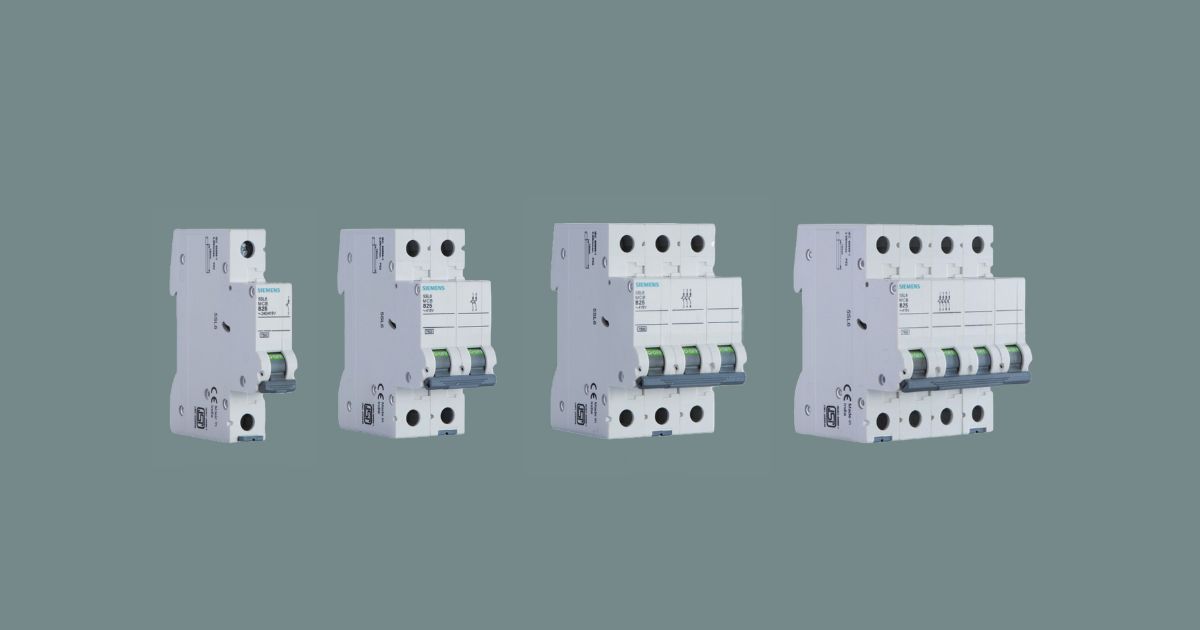Electrical protection devices play an essential role in ensuring the safety, reliability, and operational stability of power distribution systems. Among the many circuit protection options available, the 4 pole MCB stands out for its ability to provide comprehensive protection in three-phase applications while also safeguarding the neutral conductor.
Selecting and deploying the right type of 4 pole MCB is critical for reducing downtime, maintaining system performance, and preserving electrical equipment. Read more to understand what the role of a 4 pole MCB is in managing your network.
Understanding the 4 Pole MCB
A 4 pole MCB is an automatically operated circuit breaker designed to protect all three phases and the neutral line from overcurrent and short circuit conditions. It operates on the same principle as standard miniature circuit breakers but offers extended coverage by incorporating protection for the neutral conductor. This makes it especially valuable in systems where neutral continuity is vital for operational safety.
The device operates using two tripping mechanisms:
- Thermal Tripping: Responds to sustained overloads by heating a bimetallic strip until it bends and trips the circuit.
- Magnetic tripping: Reacts instantly to severe short-circuit currents using an electromagnetic release mechanism.
Key Advantages of a 4 Pole MCB
The integration of a 4 pole MCB into modern power systems offers several advantages:
- Complete Phase and Neutral Protection: Prevents damage caused by overloads or faults across all live conductors, including the neutral.
- Improved Safety in Unbalanced Loads: Particularly useful in systems where unbalanced loads could cause excess current in the neutral conductor.
- Simplified Isolation: Allows full disconnection of all conductors, facilitating safe maintenance and repair work.
- Enhanced Equipment Longevity: Protects sensitive electrical devices and instruments from abnormal current conditions.
Applications in Modern Electrical Networks
The 4 pole MCB is widely used in:
- Industrial Distribution Boards: For machinery and equipment requiring complete isolation.
- Commercial Power Systems: Where load balancing and neutral protection are essential.
- Renewable Energy Systems: Including solar power setups to ensure consistent safety.
- Critical facilities: Facilities like hospitals and data centers, where uninterrupted operation is crucial.
Selecting the Right 4 Pole MCB
Choosing an appropriate 4 pole MCB requires careful consideration of the following factors:
- Rated Current (In)
The rated current should match or slightly exceed the maximum expected load to prevent nuisance tripping.
- Trip Curve
- Type B: Suitable for resistive loads.
- Type C: Ideal for mixed loads with moderate inrush currents.
- Type D: Appropriate for heavy inductive loads with high starting currents
- Breaking Capacity
Select a 4 pole MCB with a breaking capacity that matches the maximum prospective short-circuit current in the network.
- Coordination with Other Devices
Ensure proper discrimination between the 4 pole MCB and upstream or downstream protection devices so that faults are isolated without disrupting the entire system.
Reducing Downtime Through Proper Deployment
When correctly selected and installed, a 4 pole MCB reduces downtime by:
- Preventing unnecessary tripping caused by transient surges or start-up currents.
- Allowing quick restoration of power after a fault through simple reset functions.
- Minimizing equipment damage and avoiding extended repair delays.
Best Practices for Installation and Maintenance
To maximize the benefits of a 4 pole MCB:
- Conduct Load Analysis: Determine actual operating currents and inrush patterns before device selection.
- Use Quality Terminations: Secure all connections to prevent overheating.
- Periodic Testing: Verify tripping characteristics during routine maintenance.
- Environmental Considerations: Install within enclosures that protect against dust, moisture, and temperature extremes.
Integration with Broader Protection Systems
In complex electrical networks, the 4 pole MCB should be incorporated into a layered protection scheme that may also include residual current devices (RCDs), surge protective devices (SPDs), and molded case circuit breakers (MCCBs). This layered approach ensures:
- Quick and accurate fault isolation
- Protection against different fault types
- Improved overall system reliability
Benefits of Collaborating with a Reputed Electrical Brand
Selecting and deploying a 4 pole MCB requires more than just matching current ratings. Partnering with a reputed electrical brand offers:
- Certified High-performance Devices: Products tested for compliance with global safety standards.
- Technical Expertise: Professional guidance on load profiles, trip curves, and integration strategies.
- Diverse Product Range: Availability of devices suitable for different industries and applications.
- Long-term Support: Assistance in troubleshooting, upgrades, and compliance documentation.
By working with a trusted brand and ensuring proper installation, a 4 pole MCB can deliver dependable protection, reduced downtime, and long-term operational efficiency.
Why a 4 pole MCB is a Strategic Investment
Selecting a 4 pole MCB is a technical choice and a strategic decision that influences the safety, reliability, and efficiency of an electrical network. Its capability to protect all three phases, along with the neutral conductor, ensures uninterrupted operations and safeguards critical assets. By pairing accurate specifications with products from a reputable electrical brand, organizations can significantly reduce downtime, extend equipment life, and maintain optimal performance in demanding environments.




